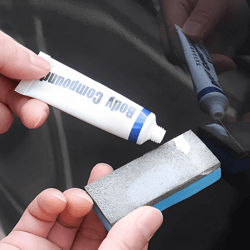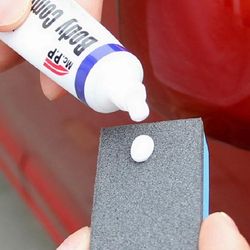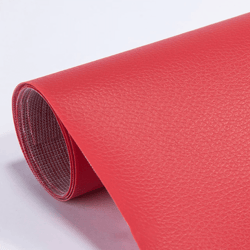FENOM FN957 Repair kit for local galvanizing of the car body KOROCIN
Quantity
FENOM FN957
Repair kit for local galvanizing of the car body KOROCIN
Elimination of corrosion centers on the car body by electrolysis and applying a protective zinc layer to metal parts by galvanic method.
The use of the kit provides:
Elimination of foci of corrosion on the car body.
Exclusion of secondary formation of corrosion centers after repair and painting.
Application (restoration) of a protective anti-corrosion zinc layer on the metal elements of the car body with a total area of up to 0.8 m2.
A significant improvement in the quality of body repair, including in a car service.
A radical increase in the life of the car body.
Mechanism of action:
Rust removal by electrolysis from the damaged area.
Application of a protective zinc layer on metal parts by galvanic method.
Kit contents:
Solution No. 1 (200 ml) - 1 pc.
Solution No. 2 (200 ml) - 1 pc.
Transparent container (30 ml) - 2 pcs.
Electrode with handle - 1 pc.
Steel nut-anode - 1 pc.
End bolt for steel anode nut - 1 pc.
Cylindrical zinc anode - 1 pc.
Electric wire (5 m) with terminal and clip - 1 pc.
Small felt applicator - 1 pc.
Large felt applicator - 1 pc.
Sandpaper sheet - 1 pc.
Required equipment and conditions of use
A serviceable car battery with a voltage of 12 V and a capacity of at least 50 Ah.
The temperature of solutions and ambient air is above 0°C.
Mechanical devices for removing loose rust (if necessary).
Advantages of the KOROCIN kit over similar repair kits
bodies by galvanic method:
Thanks to a 5-meter long wire, any part of the body can be processed.
Two additional containers included in the kit prevent premature contamination of solutions.
An additional felt applicator allows you to extend the life of the kit.
The large area of the zinc anode makes the galvanizing process more efficient and allows large areas to be treated.
STAGE #1. RUST REMOVAL
1.1 Mechanically remove loose paint and loose rust from the damaged area of the body.
1.2. Screw the anode steel nut onto the electrode thread. Lock the nut on the electrode with the end bolt.
1.3. Slide the small felt applicator onto the anode steel nut.
1.4. Pour solution No. 1 into the attached container to a level of 2/3 of its height.
1.5. Dip the felt applicator into the container and wait until it is completely impregnated.
1.6. Connect the wire clamp securely to the positive battery terminal.
1.7. Apply the felt applicator to the corroded area. Move the applicator very slowly over the surface until all rust is removed. The composition will evaporate, therefore, if necessary, lower the applicator into the impregnation container (see paragraph 1.5). When treating large areas, it will be necessary to periodically rinse the applicator with water to remove accumulated rust on it.
1.8. After completing the procedure, disconnect the clip from the battery terminal and remove the applicator.
1.9. Rinse the cleaned surface and applicator with water, then dry.
STAGE #2. APPLICATION OF A PROTECTIVE ZINC LAYER
2.1. Remove rust from the surface according to solution #1 instructions (see Step 1: Rust Removal).
2.2. Unscrew the steel anode nut from the electrode and screw on the cylindrical zinc anode instead.
2.3. Place a large felt applicator over the zinc anode.
2.4. Pour solution No. 2 into the attached container to a level of 2/3 of its height.
2.5. Dip the felt applicator into the container and wait for it to completely soak.
2.6. Connect the wire clamp securely to the positive battery terminal.
2.7. Place the felt applicator on the area to be treated and move the applicator across the surface with quick circular movements without pause. Do not stop!
ATTENTION: With the correct rhythm, the surface will turn gray. Avoid dark spots. If they have arisen, then remove them by rhythmically moving the applicator over them.
IMPORTANT: The composition will evaporate, so periodically dip the electrode tip into the applicator soaking container.
2.8. After completing the procedure, disconnect the clip from the battery terminal and remove the applicator.
2.9. Rinse the galvanized surface and the applicator with water, then dry.
WARNING: Do not leave the connected electrode on a metal surface. Avoid short circuits.









